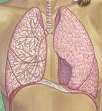What Are The Functions Of The Respiratory System
By: Dr. Rita Louise
 Did you ever wonder what the function of the respiratory system is? The respiratory system is an intricate arrangement of spaces and passageways that conduct air from outside the body into the lungs and finally into the blood as well as expelling waste gasses. This system is responsible for the mechanical process called breathing, with the average adult breathing about 12 to 20 times per minute.
Did you ever wonder what the function of the respiratory system is? The respiratory system is an intricate arrangement of spaces and passageways that conduct air from outside the body into the lungs and finally into the blood as well as expelling waste gasses. This system is responsible for the mechanical process called breathing, with the average adult breathing about 12 to 20 times per minute.
When engaged in strenuous activities, the rate and depth of breathing increases in order to handle the increased concentrations of carbon dioxide in the blood. Breathing is typically an involuntary process, but can be consciously stimulated or inhibited as in holding your breath.
Nostrils/Nasal Cavities
During inhalation, air enters the nostrils and passes into the nasal cavities where foreign bodies are removed, the air is heated and moisturized before it is brought further into the body. It is this part of the body that houses our sense of smell.
Sinuses
The sinuses are small cavities that are lined with mucous membrane within the bones of the skull.
Pharynx
The pharynx, or throat carries foods and liquids into the digestive tract and also carries air into the respiratory tract.
Larynx
The larynx or voice box is located between the pharynx and trachea. It is the location of the Adam’s apple, which in reality is the thyroid gland and houses the vocal cords.
Trachea
The trachea or windpipe is a tube that extends from the lower edge of the larynx to the upper part of the chest and conducts air between the larynx and the lungs.
Lungs
The lungs are the organ in which the exchange of gasses takes place. The lungs are made up of extremely thin and delicate tissues. At the lungs, the bronchi subdivides, becoming progressively smaller as they branch through the lung tissue, until they reach the tiny air sacks of the lungs called the alveoli. It is at the alveoli that gasses enter and leave the blood stream.
Bronchi
The trachea divides into two parts called the bronchi, which enter the lungs.
Bronchioles
The bronchi subdivide creating a network of smaller branches, with the smallest one being the bronchioles. There are more than one million bronchioles in each lung.
Avleoli
The alveoli are tiny air sacks that are enveloped in a network of capillaries. It is here that the air we breathe is diffused into the blood, and waste gasses are returned for elimination.